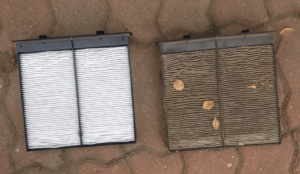
From our trusted AAA repair articles. Check out the latest on changing your A/C Filter.
New cars are increasingly equipped with cabin air filters that remove particulates, and sometimes odors, from the air that enters the vehicle through the heating, ventilation and air conditioning (HVAC) system. Cabin air filters are usually standard equipment on premium models, while other cars make them available as a stand-alone option or part of an option package. Some luxury cars have two or more cabin air filters.
The types and sizes of contaminants a cabin air filter can trap vary with the specific filter design. However, a general list includes dirt, dust, leaves, twigs, insects, soot, smog, mildew, pollen, mold, spores, fungi, bacteria, germs, rodent droppings and other undesirable debris.
A cabin air filter is more than just a way to improve air quality; it can also affect vehicle safety. The Filter Manufacturers Council estimates that 40 million Americans suffer from allergies caused or made worse by airborne particulates. By removing those contaminants, a cabin air filter can reduce or eliminate symptoms such as sneezing, blurred vision, runny nose, and headaches that could distract a driver and result in a collision.
Filter Types
Most cabin air filters have a pleated filtering medium that looks like paper, but is actually a more complex material made of natural and/or synthetic fibers. The filter’s physical characteristics trap most contaminants and in many designs, the passage of air over the filter creates an electrostatic charge that helps attract and trap smaller particles. Quality filters may have several layers that support the filtering medium and offer different types and degrees of filtration.
Not all cabin air filters are created equal. As the quality of a cabin air filter increases, so does its price. A basic filter may cost $15 at a local auto parts store; while a premium original equipment part may be $50 or more when purchased from a car dealer.
Standard cabin air filters are typically around 98 percent efficient at trapping particulates in the 5-100 micron range. This includes the majority of contaminants, but not the smallest particles of mold, spores, soot and tobacco smoke.
High Efficiency Particulate Air (HEPA) cabin air filters can trap even finer particles. One major supplier claims their premium HEPA cabin air filters have a filtration efficiency of 99.97 percent at 0.3 microns based on standardized industry testing. While they cost more, HEPA filters provide the ultimate protection against airborne particles.
Besides filtering particulates, many cabin air filters are chemically treated with activated carbon that gives them a gray appearance and helps remove a wide variety of odors. These include exhaust gas smells such as ammonia, sulfur dioxide, nitrous oxides, hydrogen sulfide and benzenes from incomplete combustion. Some cabin air filters supplement carbon with baking soda to neutralize a wider range of smells, including odors from the human body, wet-dogs and mildew.
Filter Replacement
There are three factors to consider when determining if your car’s cabin filter needs to be replaced:
Mileage: Factory recommended intervals for replacing cabin air filters range from 15,000 to 30,000 miles. Ask your auto repair shop or check your auto’s owner’s manual for exact mileage specifications.
Levels of fine particulate matter: You may need to replace the filter more frequently if you drive in an area that has higher than normal levels of dust, pollen and other airborne debris. Many motorists are shocked when they see how many contaminants cover the surface of a cabin air filter that has been in service for an extended time.
Performance: Symptoms of a restricted cabin air filter include reduced airflow through the HVAC system, windows that fog up easily and are hard to defrost, and persistent bad odors. A restricted cabin air filter also places a greater load on the ventilation fan and can shorten its service life.
Cabin air filters are located in the ductwork that delivers outside air to the HVAC system. In some cars, the filter is in the engine compartment near the base of the windshield. In others, it is located under the dash or behind the glove box. Most cabin air filters can be replaced in less than 15 minutes without tools, although some take a little longer and may require removing fasteners that hold the glove box or interior trim panels in place. If you need help replacing your filter, check with your local auto repair shop.
There is also good news for some drivers whose cars came without a cabin air filter. To reduce the number of different parts they have to manufacture, many automakers use the same HVAC ductwork on every trim level of a given model. As a result, if your owner’s manual talks about cabin air filter replacement, there is a good chance the car is equipped to accept one, even if a filter was not installed at the factory. Simply follow the replacement instructions to determine whether the ductwork contains the necessary filter housing.
Finding Quality Auto Repair
AAA recommends that you plan ahead for vehicle service by finding an auto repair shop and technician you can trust before you need them. AAA.com/AutoRepair provides information on nearly 7,000 Approved Auto Repair facilities that have met AAA’s high standards for appearance, technician training and certification, insurance coverage and customer satisfaction. AAA regularly inspects every Approved Auto Repair facility and surveys their customers to ensure ongoing performance. In addition, AAA members receive special benefits that include auto repair discounts, an extended 24-month/24,000-mile parts and labor warranty, and AAA assistance in resolving repair-related issues.






